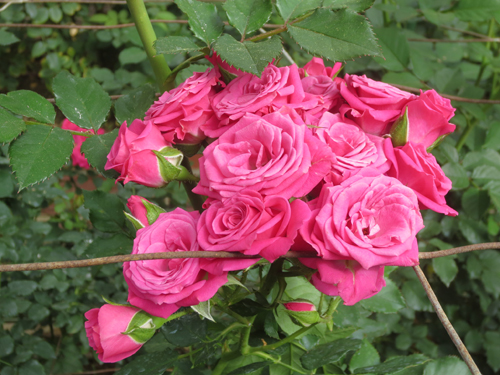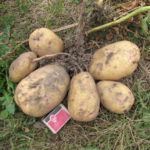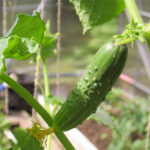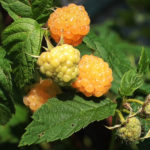Rose Lovely Lydia
New groups of roses are of great interest to people who have love and craving for experimentation. For example, varieties from the spray category look very attractive. Experts call the Lovely Lydia variety the true standard of this series. They have enough reasons to think so.
History of origin
Rose Lovely Lydia is the creation of Interplant, based in Holland. This variety was bred by the breeders of the indicated rose-growing company back in the last century - in 1995. Despite the fact that, according to the classification, this culture is a spray rose, in fact it is a sport of the floribunda Lydia. The variety has another name: Nterkuyl.

Description of appearance and features
The Dutch perennial is a small but rather spreading shrub, barely reaching a height of 70 cm, and growing about half a meter in width. Not distinguished by an impressive length, shoots devoid of sharp thorns refresh the oblong leaves of a dark green hue. The flowers of the plant are formed in neat inflorescences, bouquets of 5-10 pieces. They are not impressive in their size (no more than 4 cm in diameter), but they have a perfectly regular shape and unusual color, ranging from rich pink to a bright raspberry shade with pink-cream or lilac tints. In the phase of complete dissolution, the flowers show the dark center to the faces admiring them. In each flower of the European rose, there are about 40 petals with wavy edges. The noble plant blooms profusely, magnificently, practically without interruption throughout the summer period. At the same time it spreads around itself a pleasant aroma of medium intensity.
The Lovely Lydia variety is distinguished by good resistance to powdery mildew, black spot and high - to gray rot, brown spot, late blight, rust. It can hibernate without shelter when the air temperature drops to minus 23 ºС. The flowers of this plant are not afraid of precipitation and direct rays of the sun: they do not lose their shape under the influence of the former and do not fade under the influence of the latter. In general, this spray rose is a godsend for your flower garden!
Growing and care
The culture should be planted in the area of the site where partial shade reigns most of the day. Full shade is not suitable for cultivating it, otherwise you will not see the excellent flowering of the decorative perennial in all its glory. For planting a Dutch variety, it is recommended to use a loose, light, slightly acidic soil rich in humus. At the bottom of a hole 40 cm deep, a layer of a mixture consisting of small pebbles and sand is laid so that the water does not stagnate when watering the plant. Then organic fertilizer is applied to the planting pit. You can also add some chopped oak bark. Only after that comes the turn of the soil. And then they start planting roses. When this procedure comes to an end, the soil around the plant should be tamped a little, and the culture should be watered abundantly.

A decorative perennial needs full-fledged comprehensive care, consisting of:
- regular moistening of the soil under the flower with settled, not cold water;
- top dressing with nitrogen and phosphorus-potassium fertilizers throughout the growing season;
- loosening and mulching the earth in the area of the trunk circle;
- compulsory pruning of shoots.
The soil under the rose bush is loosened no earlier than a day after watering. Straw or shredded bark can be used as mulch.
In the spring, the bush is pruned in order to get rid of dried, frozen and too weak, thin, and therefore unviable branches. Strong stems shorten a little.In the summer, it is important to remove dried inflorescences, stems that contribute to thickening of the shrub in time, and produce formative pruning. In the fall, pruning is carried out in relation to all shoots without exception. After the performed actions, the culture is spud with dry soil and covered with spruce branches or a more serious insulation in the case of growing a perennial in an area with extremely cold winters.
Of the pests, the variety can damage spider mites, thrips and aphids. To prevent their appearance on the plant, the shoots of the rose bush are treated with an insecticide solution several times per season.
Use cases
Rose Lovely Lydia is placed in group and single plantings against the backdrop of a grassy lawn. It is ideal for planting in curbs, mixborders, near the gazebo. Dutch culture will become a bright and unusual element of the alpine slide. In mixed compositions, the plant is in complete harmony with irises, phloxes, lavender, sage, bells, veronica, wormwood, crown lichen. Beautiful combinations of rose spray with low-growing conifers and dwarf willows. The variety is suitable for landscaping balconies, loggias, terraces, as it can be cultivated in containers. It is also grown for cutting, since the flowers of a wonderful plant retain an attractive appearance for a long time, without crumbling, and the bouquets with them are simply delicious, full of tender charm.








